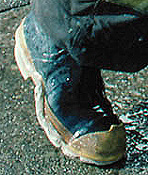Neuroscience For Kids
Smelling A Shoe To Treat Epilepsy?
January 24, 2009

Epilepsy has sometimes been called an "electrical brainstorm" because of the abnormal electrical signals in the brain that occur during a seizure. During a seizure, people with epilepsy may have trouble thinking, moving, seeing and hearing. For thousands of years, people have tried different ways to prevent or reduce the severity of a seizure. Many effective drugs are currently available for people with epilepsy.
 A paper by Dr. Harinder Jaseja describes a strange-sounding ancient
epilepsy therapy still used in rural areas of India: smelling a
shoe! Apparently when a person has a seizure in public, a common
first aid practice is to bring the sole of a shoe near the patient's
nostrils. This is done to stop a seizure. This method may sound bizarre
and unscientific, but Dr. Jaseja suggests a reason why shoe smelling might
work.
A paper by Dr. Harinder Jaseja describes a strange-sounding ancient
epilepsy therapy still used in rural areas of India: smelling a
shoe! Apparently when a person has a seizure in public, a common
first aid practice is to bring the sole of a shoe near the patient's
nostrils. This is done to stop a seizure. This method may sound bizarre
and unscientific, but Dr. Jaseja suggests a reason why shoe smelling might
work.
 Aromatherapy
is the practice of using smells to treat disease. Although some odors may
start seizures, modern research has demonstrated that some strong smells
can lessen the severity of a seizure. It may be that strong odors
interfere with the abnormal, synchronized electrical activity of neurons
during a seizure. Nevertheless, the effectiveness of smelling a shoe to
treat epilepsy has not been studied.
Aromatherapy
is the practice of using smells to treat disease. Although some odors may
start seizures, modern research has demonstrated that some strong smells
can lessen the severity of a seizure. It may be that strong odors
interfere with the abnormal, synchronized electrical activity of neurons
during a seizure. Nevertheless, the effectiveness of smelling a shoe to
treat epilepsy has not been studied.
According to the Epilepsy
Foundation, first aid for
a person having a generalized tonic clonic (grand mal) seizure, should
include: 
- Keep calm.
- Don't hold the person down or try to stop his movements.
- Time the seizure with your watch.
- Clear the area around the person of anything hard or sharp.
- Loosen ties or anything around the neck of the person that may make breathing difficult.
- Put something flat and soft, like a folded jacket, under the patient's head.
- Turn the person gently onto one side to keep the airway clear.
- Do not try to force the mouth open with any hard implements or with fingers. It is not true that a person having a seizure can swallow his tongue. Efforts to hold the tongue down can injure teeth or jaw.
- Don't attempt artificial respiration except in the unlikely event that a person does not start breathing again after the seizure has stopped.
- Stay with the person until the seizure ends naturally.
- Be friendly and reassuring as consciousness returns.
- Offer to call a taxi, friend or relative to help the person get home if he seems confused or unable to get home by himself.
For more information, see:
- Jaseja, H., Scientific basis behind traditional practice of application of "shoe-smell" in controlling epileptic seizures in the eastern countries, Clin Neurol Neurosurg, 110:535-538, 2008.
- Epilepsy - Neuroscience for Kids
- Seizures and Epilepsy
Copyright © 1996-2009, Eric H. Chudler, University of Washington
